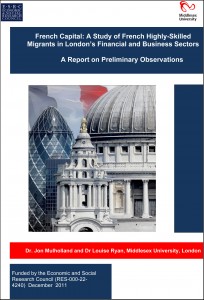Working in a migration research centre, I have come to dread the point in the conversation with a stranger when they ask what I do. From cab drivers to school gate acquaintances, everyone seems to have an opinion on migration – usually a strong opinion, almost always an ill-informed one.
A recent poll by Ipsos Mori for the Royal Statistical Society found that we, the British public, think 31% of the UK population are immigrants; in reality, it’s just 13%. We think 30% of the population is Black or Asian and 24% is Muslim; it’s actually just 11% and 5% respectively.
 Of course, the media and politicians play a major role in shaping such dramatic misperceptions, and perhaps there is relatively little academics can do to shine the weak light of actual evidence on to public debate.
Of course, the media and politicians play a major role in shaping such dramatic misperceptions, and perhaps there is relatively little academics can do to shine the weak light of actual evidence on to public debate.
I recently participated in a very interesting piece of research by Home Office Science on the vital question of the local impacts on public services, local economies and social cohesion associated with different kinds of international migration. I wrote a blogpost for The Conversation on the media misrepresentation of the report, probably partly shaped by the way the report was spun by the government to fit a particular agenda. A fellow academic wrote in OpenDemocracy on the same report, but argued that the very framing of the research questions was inherently problematic and that scholars need to be much more wary of collaborating in government research on this topic. While agreeing with many of his criticisms, my view is that the risk of getting our hands dirty by intervening in public debates is necessary if our work on social issues is to speak beyond the ivory tower.
One of the small ways in which COMPAS attempts to bring evidence into public debate is the Breakfast Briefings we have been organising for the last three years: monthly briefings from researchers on key immigration topics, aimed at Westminster policy makers. The Briefings aim to make complex issues easy to digest and provide a neutral forum for informed debate on the implications of the research tells us. I wrote a post here a year ago, entitled “The Light of Evidence” on the previous series. This post is about the 2012-13 season.
The season was kindly hosted by the Institute for Strategic Dialogue (ISD), an independent think tank, and we are grateful to the Institute and its staff for this partnership which we are glad will continue in the coming year. Like COMPAS, ISD values bringing researchers and other actors together in a dialogue that can lead to policies which create better results.
The numbers game
The 2012-13 series opened powerfully with a briefing by Jon Simmons, who is responsible for migration and border analysis at Home Office Science. Jon looked at what we know from migration statistics, and gave us new lenses which make us think differently about tired debates about numbers.
 For example, stepping back to track changes over a longer time period enables us to see some deeper historical trends than public debates normally allow, but also why the post-1997 period is so different from previous cycles in our migration story, with a scale of change that is profoundly new.
For example, stepping back to track changes over a longer time period enables us to see some deeper historical trends than public debates normally allow, but also why the post-1997 period is so different from previous cycles in our migration story, with a scale of change that is profoundly new.
A longer view also brings into focus the interesting effects of economic changes. For example, EU nationals’ immigration tailed off dramatically with the economic crisis of 2008, but EU nationals’ emigration dropped off more rapidly, keeping net migration relatively buoyant. Among non-EU migrants too, the economy impacts directly on the numbers of work immigrants: the temporary economic recovery in late 2010 correlated with a rallying of labour in-flows.
But our migration landscape is complex; a policy debate skewed to EU migrants or labour migrants misses much of the story when only a third of migrants (and just a sixth of non-EU migrants) come here for work. Thus focusing in closer to dis-aggregate our migration data enables us to see trends differently. For example, the migration behaviour of British citizens has changed over time. Even in the last decade, there has been a big drop in Brits emigrating since a recent peak at close to 200,000 in 2006 to a long-term low of little more than 100,000 in 2010. A rise in UK nationals’ out-migration in 2011 was one part of a drop in net migration that has enabled the government to be more optimistic about meeting its target.
Similarly, non-EU immigration actually dropped off during the UK’s peak migration years from 2004 until the financial crisis hit, but has risen again during the austerity years, now accounting for 55% of in-flow. Six in ten of these non-EU immigrants are students – many of whom, as we know from the Home Office Migrant Journey research, stay on in the UK, often to work and some eventually to obtain settlement. And while public debate about students focuses on universities, whose international students bring massive economic benefits to our towns, only half of students coming here in universities, and interestingly more of these are postgrads than undergrads.
Looking at the trends in student migration, which dramatically rose from 2005, Jon argued that the relative accuracy of the much-criticised International Passenger Survey (IPS) on which net migration calculations are based can be seen by how closely it tracks student visas. Jon’s presentation also shed light on a more recent debate about how we calculate migration, as he pointed out that 45% of the ONS’s underestimation of migration during the peak 2004-8 period was due to an undercount in the 2001 Census which was used as a baseline.
The figure of the migrant
One of the key lessons from all this is that the abstract, aggregate figure of “the migrant”, who looms so large in public debate, is to some extent a fiction. As Jon wrote in his forward to the Home Office’s local impact study, “When speaking about migrants and the impact of migration, migrants are often referred to as if they are a unified group…. However, like other groups within the population, migrants do not comprise a singular type with similar impacts.”
Consequently, a number of our Breakfast Briefings focused in on very specific populations, showing the dramatic range of experiences – from undocumented children, to family migrants, to students and graduates, to high-skilled Europeans. Understanding the specific migration trajectories, integration pathways and policy challenges associated with each of these groups is a distinct task.
 Thus, for instance, Middlesex University sociologists, Jon Mulholland and Louise Ryan (Co-Director of the Social Policy Research Centre) presented research from their recently concluded ESRC-funded project on high-skilled French migrants in London. I found this presentation especially fascinating because the French in London are in many ways an invisible population, rarely featuring in policy and public debates, yet arguably provide the best example of the “parallel lives”, “self-segregation” and “unwillingness to integrate” spoken of by our politicians and pundits – even though they are also exemplary of “the brightest and best” our politicians most want to attract.
Thus, for instance, Middlesex University sociologists, Jon Mulholland and Louise Ryan (Co-Director of the Social Policy Research Centre) presented research from their recently concluded ESRC-funded project on high-skilled French migrants in London. I found this presentation especially fascinating because the French in London are in many ways an invisible population, rarely featuring in policy and public debates, yet arguably provide the best example of the “parallel lives”, “self-segregation” and “unwillingness to integrate” spoken of by our politicians and pundits – even though they are also exemplary of “the brightest and best” our politicians most want to attract.
Churn and stability
Joanna Sage, a geographer at one of COMPAS’s sibling ESRC research centres, the Centre for Population Change (CPC) at Southampton University, explored the migration pathways of UK graduates. Joanna presented research conducted with her CPC colleagues Maria Evandrou and Jane Falkingham. CPC’s mission is to examine the drivers and implications of population change in the UK – one aspect of which is migration – and the presentation was a departure for our Breakfast Briefings in looking at internal as well as international migration. These are fields which are all too often kept separate in our public debates, even though their effects at a local level are often similar.
As Joanna pointed out, students and graduates are highly mobile groups – 16-24 year olds are the most mobile age group, and those who participate in HE are more mobile than those who do not – so the pathways of “the most mobile of the most mobile” makes them key drivers of both internal and international migration flows to, from and within the UK. The drop in labour migrants with the onset of the economic crisis while the global education market grew meant that students have been the largest group of international migrants in the UK for some years now – although their number is dropping due to stringent government measures mainly targeting further education and language students.
However, students are a major driver of inter- and intra-regional movement within the UK, part of a process of seasonal churn that can cause tensions in university towns, despite the economic contribution that students make where they live. This kind of local migration impact needs to be placed alongside the sort the Home Office research focused on.
Much of the literature on graduate migration focuses on graduates moving university towns into the southeast and London, which are said to act as “elevators” for graduate social mobility. However, the CPC research, using a complex and innovative “event history survey” methodology, challenges this view. In fact, about a fifth of graduates are relatively geographically stable, including nearly four in ten mature students, with constraints relating to the labour market keeping many in place. A “double boomerang” effect is in play, with students returning to the parental home after graduation, then moving out again but returning due to economic pressures.
Interestingly, the CPC research suggests that international students are more likely to be among the stable rather than the mobile, with 64% staying in the UK, of whom over half in the same address five years after graduation – while a third of those leaving the country returned within five years for work or further study. It remains to be seen the extent to which this will change as new restrictions designed to reduce net migration start to affect graduates’ choices, but if it does it will impact on university towns.
Housing, jobs and welfare
As well as briefings on particular groups of migrants, we hosted briefings on particular policy issues. A second CPC briefing, by Jackline Wahba, explored the role of social networks in migrants’ access to jobs in the UK. The research showed that less educated migrants depend more on social networks to access work. But the briefing revealed a fascinatingly variegated picture, with some groups relying more on social networks the longer they are in the UK but other groups relying on them less, meaning networks are an unpredictable marker for integration. This clearly has important implications for how we think of employment services, but also how we conceptualise the impact of migrant workers on the UK labour market.
 The work of the JRF Housing and Migration Network was showcased in a briefing by Neil Coles (Chair of the National Houses in Multiple Occupation Network, and Housing Services Manager at Maidstone Borough Council) and Gill Green (an independent researcher whose report 2007 Audit Commission report Crossing Borders: Responding to the Local Challenges of Migrant Workers was the first real reckoning with the impact of the mass migration of the noughties).
The work of the JRF Housing and Migration Network was showcased in a briefing by Neil Coles (Chair of the National Houses in Multiple Occupation Network, and Housing Services Manager at Maidstone Borough Council) and Gill Green (an independent researcher whose report 2007 Audit Commission report Crossing Borders: Responding to the Local Challenges of Migrant Workers was the first real reckoning with the impact of the mass migration of the noughties).
They spoke about migrants in the private rented sector, exploring what the evidence tells us, but also practical steps local authorities and governments can take to improve the situation by acting on the evidence. For example, they argued that migration needs to be part of mainstream housing policy, planning and provision; that we need to focus on the “bottom end” of the rented sector as changing housing and welfare policies create new patterns; and that we need more co-ordination across the many national and local bodies involved (something especially fragile in an age of austerity).
Presentations by Juan Camilo of the Migrants’ Rights Network and Caroline Oliver of COMPAS looked at the impacts of changing family immigration on the lives and integration of family migrants. Juan, drawing on MRN and All-Party Parliamentary Group research, focused on the impact of the minimum income requirement, one year on. Caroline, drawing on emerging findings from the IMPACIM project (which she is working on with Hiranthi Jayaweera and other colleagues), explored the effect of restricting entitlements on integration.
Caroline’s findings point towards restricting entitlements posing risks to integration, but also suggest that there is not simply an issue with restrictions on entitlements, when complexity of rules, procedural delays and shortage of services can restrict access to rights. Juan’s presentation focused on the costs to individual families. He also pointed to cases of wealthy families unable to meet the requirement due to evidential requirements, and of cases where separation increases the use of public funds: (for example, where new mothers stay at home, or where elderly parents in the UK are cared for by a local authority rather than family).
Both presentations honed in on policy trade-offs. Juan showed how immigration priorities (bringing down net migration) contradicts other policies (support for marriage or the aspiration to be a family-friendly government); Caroline showed how new rules have impeded family migrants learning English, despite Eric Pickles giving speaking English a central role in his “integration, integration, integration” mantra.
Integration
A number of our Breakfast Briefings focused on integration. Ludi Simpson and Stephen Jivraj of the Centre on Dynamics of Ethnicity (CoDE), another ESRC research centre at the University of Manchester, gave us a summary of some of their incredibly valuable Census analysis, exploring what the 2011 Census tells us about integration and diversity in contemporary England and Wales.
While the White British population has remained fairly stable, the minority ethnic population has grown since 1991 and ethnic diversity is increasing almost everywhere. “Super-diverse” areas are clearly emerging, but the general picture is of a dispersing, spreading, and suburbanising minority ethnic population, creating new plural cities and less homogenous suburbs. While there are lower numbers of white in the most diverse areas, there is no evidence of white flight, but rather a general pattern of populations moving out of inner cities to lower density areas so that segregation is decreasing dramatically.
Another sign of mixed Britain is the increase and geographical spread of multiple ethnicity households. Stephen and Ludi also presented fascinating data on who feels British – the answer being not the White British as much some ethnic minorities, notably Bangladeshi, Pakistani, Indian and Caribbean ethnicity residents. With these issues, there are less direct implications in terms of policy, but what is clear is that the evidence points to a picture dramatically at odds with the panicked approach to diversity that drives much of our integration debate.
 Vidhya Ramalingam of the Institute for Strategic Dialogue presented emerging findings from a project funded by the Open Society Institute on what works in integration policy. She described the contending principles and lack of policy coherence in the field and the dangers of the heavy politicisation of the topic. She showed, however, that local practitioners, in all sectors, are able to pursue a pragmatic “get on with it” approach that gets results.
Vidhya Ramalingam of the Institute for Strategic Dialogue presented emerging findings from a project funded by the Open Society Institute on what works in integration policy. She described the contending principles and lack of policy coherence in the field and the dangers of the heavy politicisation of the topic. She showed, however, that local practitioners, in all sectors, are able to pursue a pragmatic “get on with it” approach that gets results.
She argued that governments should be aware of the ways in which mainstream policies can have unintended impacts on integration and look for ways to “integration-proof” them. While structural policies, such as labour, housing, education, and health policies, don’t directly causally impact the cultural and behavioural elements of integration, it is in these fields rather than in integration policy as such that states can a difference and deliver more value for wider society.
Extremism
Finally, Matthew Goodwin of Nottingham University’s Politics department looked at xenophobia and extremism. In a timely presentation days after the May 2013 elections, he presented how the far right had fared. The elections were a disaster for the UK’s main fascist electoral vehicle, the British National Party (BNP). From a peak in 2007/8, the BNP has declined electorally, with the emergence of a much more unpredictable, fragmented far right scene. However, the electoral rise in the UKIP vote and the street presence of the English Defence League suggests that right-wing anti-immigrant messages have some salience with a sizeable minority of the public.
This issue framed the research Matt presented, drawing on YouGov polling of EDL sympathisers for the Extremis project. While most people who have heard of the EDL see it as racist, a significant minority think it isn’t or sympathise with it even though they think it is.
 Contrary to stereotypes, EDL supporters are not young: 60% are over 44 (and half of them are over 60). Nor is sympathy restricted to the unemployed or the working class: support is fairly constant across the classes, with C2 (skilled manual workers) only slightly over-represented and non-manual workers and professionals only slightly under-represented and only 3% of supporters unemployed. They are obsessed with an imagined Muslim threat, but immigration and the economy are bigger concerns for them as individuals, and in fact xenophobia rather than Islamophobia seems to be the strongest predictor of EDL support.
Contrary to stereotypes, EDL supporters are not young: 60% are over 44 (and half of them are over 60). Nor is sympathy restricted to the unemployed or the working class: support is fairly constant across the classes, with C2 (skilled manual workers) only slightly over-represented and non-manual workers and professionals only slightly under-represented and only 3% of supporters unemployed. They are obsessed with an imagined Muslim threat, but immigration and the economy are bigger concerns for them as individuals, and in fact xenophobia rather than Islamophobia seems to be the strongest predictor of EDL support.
A wider conversation
Our Breakfast Briefings will continue after the summer, with a range of topics on the agenda. We will continue to use social media to engage people who can’t attend in the conversation. Podcasts, slides and briefing summaries are available for most of them. We hope that genuine attention to evidence can inform a less toxic immigration debate and more effective and pragmatic policy-making.